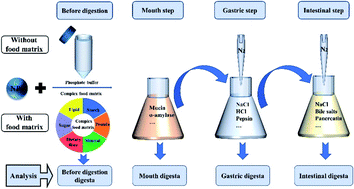Influences of a standardized food matrix and gastrointestinal fluids on the physicochemical properties of titanium dioxide nanoparticles
Abstract
The fast-growing applications of engineered titanium dioxide nanoparticles (e-TiO2-NPs) in the food and pharmaceutical industry in production, packaging, sensors, nutrient delivery systems, and food additives enhance the possibility of oral exposure. Physicochemical transformations may occur when e-TiO2-NPs are incorporated into a food matrix and pass through the human gastrointestinal tract (GIT), which may redefine the toxic effects of the e-TiO2-NPs. In this study, a standardized food model (SFM) and simulated gastrointestinal fluids have been used to study the fate of e-TiO2-NPs following a three-step digestion model in vitro, and a case study was carried out to assess the toxicity of the digested e-TiO2-NPs using an in vitro cellular model. In the absence and presence of the SFM, the transformations of the tristimulus color coordinates, size, agglomeration state, surface charge and solubility of the e-TiO2-NPs in the salivary, gastric and intestinal digestion fluids were compared with those before digestion. The results demonstrate that the presence of the SFM impacted the physicochemical properties of the e-TiO2-NPs significantly. The SFM stabilized the e-TiO2-NP suspensions and acted as a dispersant during each digestive phase. The e-TiO2-NPs showed differentiated transformations of their physicochemical properties after each step of the digestive process. The pH shifts and variable concentrations of enzymes and salts in gastrointestinal fluids induced the transformations of the physicochemical properties of the e-TiO2-NPs. The transformed e-TiO2-NPs could release titanium ion in the gastrointestinal tract. Also, the cell viability induced by e-TiO2-NPs was found to be strongly affected by the presence of the SFM and simulated human GIT fluids. It can be concluded that the physicochemical transformations of the e-TiO2-NPs that were found when they were incorporated into an SFM and passed through the GIT consequently strongly affected the biological effects of the e-TiO2-NPs, which highlights that the toxicity assessment of ingested NPs should use appropriate standardized food models and take realistic physiological conditions into account.



 Please wait while we load your content...
Please wait while we load your content...